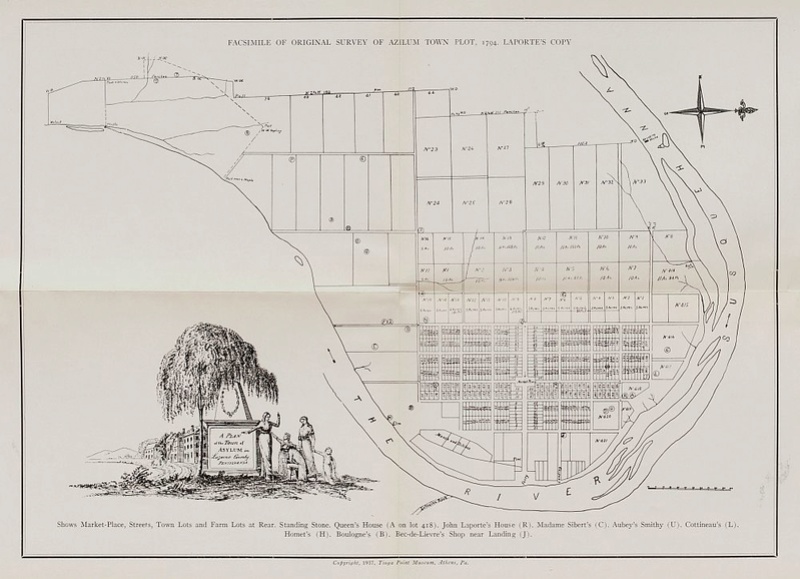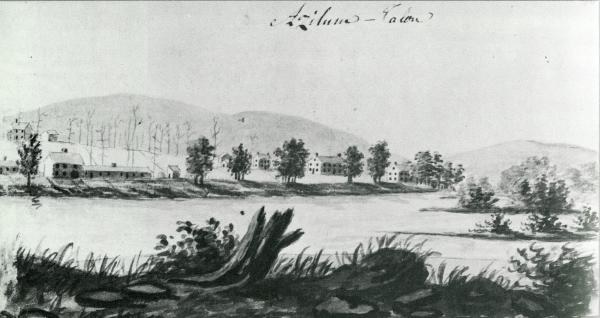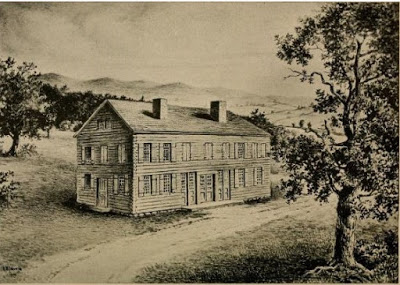Passionnant ! Hallucinant !

Un blog que je ne peux que vous recommandé (spécialisé dans le XVIIIe) fournit des explications circonstanciées.
Azilum - French émigré colony in PennsylvaniaHere on isolated bend of the Susquehanna River lies the site of the French émigré colony of Azilum. Even today it is still three and-a-half hours on the interstate from Philadelphia. The creation of this "Versailles in the Wilderness" was a remarkable testament to the determination, idealism and sheer craziness of the French exiles who fetched up in America in the 1790s.
The history of the colony is very well documented. The original impetus belonged to two larger than life characters, Lafayette's brother-in-law, the vicomte de Noailles, and the former advocate general Antoine Omer Talon, whom landed in Philadelphia from England in May 1793. Talon left his family behind in France and had escaped Revolutionary justice concealed in a wine barrel. No-one would have blamed them for waiting out their exile in the comparative comfort Moreau de Saint-Méry's French bookstore in Philadelphia, but not a bit of it. By July Noailles was writing exuberantly to his American correspondent Molly Robinson of his intention to purchase "five hundred thousand acres", not for profit, but as a refuge for the French liberal aristocracy, "to prepare an exile to those of my countrymen who, disgusted of the horrid scene which took place in France, will forever abandon the theater which has produced it." [quoted in Doina Pasca Harsanyi, Lessons from America (2010)]
Financial backing for the project was provided by two wealthy American politicians, Senator Robert Morris and the Pennsylvania Comptroller General John Nicholson. The Asylum Company was formally set up in April 1793. According to the Articles of Agreement it was intended to acquire a million acres for resale. Two agents, Charles Bué Boulogne and Adam Hoops were sent out to secure the land titles and begin the work. 125,000 acres were acquired on the disputed borders of Pennsylvania and Connecticut. The site for the settlement itself covered sixteen hundred acres in a partially cleared area known as "the Meadow". Supervised by Boulogne workman immediately began the labour of clearing land and erecting houses. All materials, even lumber, had to be ordered from Wilkes-Barre, seventy-five miles away, and pushed up river in Durham boats, a journey of four or five days; Judge Matthias Hollenback at Wilkes-Barre, who had trading posts along the river, handled much of the procurement. The colonists themselves, with their servants and possessions, would have had to make an epic trip by river from Philadelphia, either via Bethelehem and Wilkes-Barre or via Catawissa.
At the end of year first settlers appeared: in October 1793 M. du Petit-Thouars, a planter fleeing from Revolution-torn Martinique, arrived "with all his hands". Noailles made a short visit in November. It was probably at this point that the settlement was christened "Asylum" ["Azilum" in French pronunciation] The surviving town plan echoes enlightenment dreams of civilisation in the midst of the wilderness. Three hundred acres were to be utilised in a layout of neoclassical proportions, a parallelogram of broad streets centring on a two-acre market square. Talon arrived at the beginning of December to serve as manager of the colony and as its official agent drew a salary from the Company of $3000.

Original town plan, reproduced from Elsie Murray, Azilum
Despite financial and legal disputes, the colony initially grew rapidly. By the following spring, 30 rough long houses were built; .at its height in 1797-98 there were perhaps 50 or so. The duc de la Rochefoucauld-Liancourt who visited in 1795 counted 16 families and three individuals among the settlers, as well as some “families of artisans” . Thirty one individuals, with a description of the property they owned, are listed on the return for the 1798 Direct Tax. The known settlers almost all claimed nobility or noble ancestry; they included the (marquis) de Blacons, (comte) Alexandre d'Autrement, and (comte) Charles du Petit-Thouars; also several veteran officers of Rochambeau's army, a few Creoles, and professionals such as Barthélemy Laporte, a former judge. They were joined by people of more modest origins, formerly in the service of royalty - Charles Cook, cook at Versalles, and Maria Schillinger, maid-in-waiting to Marie Antoinette. A former archdeacon of Toulon, the abbé Colin de Sévigné officiated at the modest chapels.

Azilum, by Eduoard C. V. Colbert, Comte de Maulevrier, 1794.
Pennsylvania Historical Museum Commission
Efforts were made to encourage economic viability. A commercial district provided along the waterfront thrived for a while – at one time it included a grist mill, a potash works, a maple sugar refinery and a distillery. A road was cut through the forest to facilitate communication with the Company's property in the interior Breeded cattle were introduced. However, agriculture never really flourished and the colony remained heavily reliant on hired American labour.
Local Yankees wondered at the large and well-furnished houses of the French settlers. The returns for the 1798 Direct Tax indicate that the Anglo-American settlers were sparsely scattered in small log cabins, typically 16ft by 16ft or less, with few windows. Azilum houses in contrast were often 30ft by 60 ft or even larger . Although they too were crude wooden constructions, many had chimneys, wallpaper, window glass, shutters and porches.
The Grande Maison

Ill. from Murray, The story of some French refugees and their Asylum (1917)
The largest house in Azilum was a two storey-and-attic building, 84 feet long and 60 feet wide, fitted with 16 fireplaces and said to have been the largest log house ever built in America. The legend that it was known as "the Queen's House" and intended for Marie-Antoinette is based on the recollections of Elizabeth Laporte, daughter of John Laporte, one of the original settlers (Murray (1917) p.38) However, extant receipts and ledger accounts suggest that construction did not actually begin until the spring of 1794 when the exiles would already have learned of Marie-Antoinette’s death. In the event it acted as a sort of makeshift salon and setting for social gatherings, as well as accommodation for visiting guests - among them (possibly) Talleyrand and the future King Louis Philippe.
Bound together as exiles, the colony enjoyed an unusual amount of organised social life. A dancing pavilion was built on a small island adjacent to the Grande Maison. A ledge known as Table Rock was used as a picnic site. There were also inns: the first licence was granted in in 1794 to a M. Lefebre who was reputed to have once managed a cafe in Paris; others followed in 1795 and 1797. Boating, dancing, picnics, sledging on the frozen river, concerts, card parties and amateur dramatics are all recorded:
'Their amusements consisted of riding, walking, swinging, music, (and perhaps dancing), and some times they passed their time with cards, chess, or the back gammon board. In their manners, they were courteous, polite, and affable. In their living they followed their French customs. Breakfast late, on coffee, fresh meat, bread and butter. Dinner at 4 o'clock. Drank best wine or brandy after dinner, ladies and gentlemen who chose, drank tea in the evening. (I speak of the wealthy). They were able to command the best of everything'. (Judge Jonathan Stevens, quoted by Rebecca Geoffroy)
The end of the settlement
The duration of the sophisticated French town in the wilderness was brief . Economic factors, including the bankruptcy of Morris and Nicholson, led to the settlement’s decline. By the late 1790’s many of the émigrés had moved elsewhere and after 1803 they could return to France. A few families, including the LaPortes, remained and helped settle nearby communities. Azilum itself was entirely abandoned and none of the original structures remain.
Excavations at Azilum
The French Azilum Historical Site, first set up in 1955, today contains over twenty acres of the original settlement. The Laporte farm and its outbuildings, dating from the 1830s, provide a focus for visitors. There is also a replica log cabin of circa 1790, which houses a small museum. Various archaeological digs have added to the collections. In 1976 the excavation of Lot 416, confirmed an existing written description of a symmetrical "Georgian style" mansion similar to those found in the West Indies. In 1999 a midden yielded a brass door hand and a few other imported furniture fittings, plus a number of small personal objects - buttons, buckles, pins and the like. If a brass comb indicated relatively elaborate hairstyles, the number of straight pins would suggest a fair amount of home dressmaking and mending!
References
French Azilum Historic Site official website
http://www.frenchazilum.com/index.php
Catherine Falzone. "Versailles on the Susquehanna" New York Historical Society Museum and Library blog, post of 24.05.2016
http://blog.nyhistory.org/versailles-on-the-susquehanna/
Rebecca Geoffroy: Asylum "A Paris in the Wilderness", Penn State University (student research project) n.d.
https://libraries.psu.edu/about/collections/unearthing-past-student-research-pennsylvania-history/asylum-paris-wilderness
Rob Mann and Dianna DiPaolo Loren "Keeping up appearances; dress, architecture, furniture and status at French Azilum" International Journal of Historical Archaeology 5, no.4 (2001) 281-306.
[Available on JStor]
There are a couple of older, more chatty accounts, both by descendants of the Laporte family:
Louise Welles Murray, The story of some French Refugees and their Azilum (1917)
https://archive.org/stream/storyofsomefrenc00murr#page/30/mode/2up
Elsie Murray, Azilum, French refugee colony of 1793, Tioga Point Museum (1950)
https://cdm61prod.dlt.psu.edu/cdm/ref/collection/digitalbks4/id/1298
Ce blog incontournable, c'est celui-ci http://rodama1789.blogspot.be/
L'admin maîtrise !

